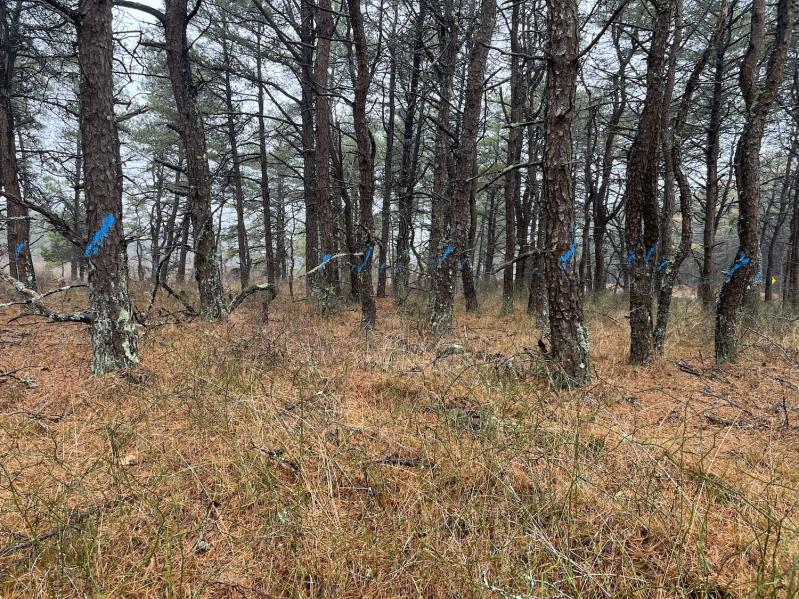East Hampton Town’s forests are under assault from multiple species, the town board was told on Tuesday, and while invasive insects are a major component of the ongoing threat to them, “more aggressive deer management” was the recommendation to alleviate forest degradation.
Andy Gaites, the town’s principal environmental analyst, delivered to the board a report on the vegetation studies he has conducted over the last nine years. “In recent years, our town has been hit by a few different pests causing detrimental harm to the forests of East Hampton,” he said. Starting in 2017, “we had tens of thousands of pitch pine trees die off” because of southern pine beetle infestation. Despite “a huge effort” by the town and the New York State Department of Environmental Conservation to suppress the insects’ invasion, “we were not able to catch up with the beetles. They have continued to spread.”
Supervisor Peter Van Scoyoc later said that more than 700 beetle-infested trees had been cut down on his own property. “We’ve seen a terrible amount of change, frankly,” owing to “pests that have arrived that could not survive here even a decade ago” because cold winters prevented it, he said.
Climate change is blamed for the northern expansion of the southern pine beetle. A 2018 study in the Journal of Forestry stated that “after more than a decade of damage in pitch pine forests of New Jersey, an unprecedented range expansion of southern pine beetle has recently occurred with populations established or detected in parts of the northeastern United States. Widespread tree mortality in pitch pine stands has occurred on Long Island, New York, an area previously free” of the insect.
Last year, beech trees began exhibiting signs of beech leaf disease, a condition that has worsened this year, Mr. Gaites said. A nematode is to blame, he said. While the full impact remains to be seen, research indicates that affected trees may die within six to 10 years. As beech forests shade out understory, there will be few to no other tree species to replace those that die, he said. This will be advantageous to invasive plant species.
While the spotted lanternfly has yet to be seen here, it has appeared in Queens County and on the North Fork. It has a wide range of host trees and “could be devastating if they take hold here,” he said.
“But there is another, more subtle, ongoing killer of trees here” and throughout the Northeast, Mr. Gaites said. “That is the herbivore browse of white-tailed deer,” which “can alter the forest ecosystem in a significant way.”
In 2014, Mr. Gaites told the board, he implemented the “10 tallest method” developed by Tom Rawinski of the United States Forest Service, in which an indicator species is chosen in multiple plots in locations across the town and the heights of the 10 tallest stems are recorded and averaged annually. “In a healthy forest, native saplings would be expected to show growth” each year. If they are instead smaller and fewer in number, that “might indicate a lot of deer browse keeping them down.”
An initial seven plots in 2014 grew to 20 across the town, he said, some with multiple indicator species in each. Of the original seven plots with nine seasons of data, and an eighth with eight seasons’ worth, most showed a decrease in average height of the 10 tallest stems. Across all 20 plots and a total of 27 indicator species, 18 species, or 67 percent, were trending downward as of the most recent measurement. Impacts are not uniform across the town, he said: plots in the Grace Estate Nature Preserve in Northwest Woods and in Montauk have shown the most dramatic impact of deer browse.
Changes are subtle and may not be discernible even to those frequenting the town’s trails and preserves, Mr. Gaites said. To demonstrate the impact of deer browse, the town erected an exclosure in the Grassy Hollow Preserve in Northwest Woods last year. But an exclosure that has existed at the Nature Conservancy’s Mashomack Preserve on Shelter Island for more than 20 years makes obvious “how thick and lush the vegetation on the inside” is, he said, with more than 30 thriving plant species inside it, in contrast to the areas outside of it, where deer can freely browse.
In summary, his studies suggest “the impact of deer on our woodlands is detrimental to forest regeneration,” Mr. Gaites said. The town does provide opportunities to hunt deer, and deer damage permits, which authorize the hunting of deer outside of the recreational hunting season, are issued for select properties. “However, a more comprehensive approach is necessary if we want to see substantial regrowth,” he said.
Thirty years ago, Mr. Van Scoyoc said, you had to move trees aside to walk through the woods, and visibility was barely 20 yards due to the thickness of woodlands. Now, he said, you can see 100 yards ahead, and there is no understory, which “impacts so many species.”
Humans long ago wiped out natural predators of deer, leaving automobiles as their biggest threat. There are years, Mr. Gaites said, in which deer-vehicle collisions exceed the number of deer killed by hunters.
“We do have a population that is out of balance,” the supervisor said of deer, quickly adding that “the same can be said for the human population.” But ensuring a balance “is, at this point, our responsibility, because we’ve meddled with the environment.” He asked Mr. Gaites for specific recommendations.
“It is a controversial issue,” was the reply, “but the general words are more aggressive deer management.”




